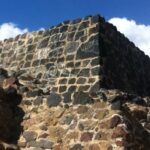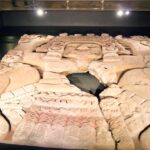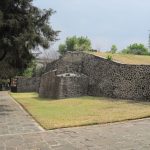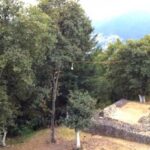
The Cuicuilco Archaeological Site is among the oldest excavated ancient cities in the Valley of Mexico. It’s certainly the oldest that you can visit. Occupied by the Cuicuilca people from 700 B.C.E to 150 C.E., it was home to some 20,000 people.
When the Xitle volcano began a series of devastating eruptions between 245 and 315 C.E. much of the area was covered in lava and the population fled. It is often noted that this time corresponds to the rise of Teotihuacán and some of the Cuicuilca people are known to have migrated to the city. A corresponding ceremonial center to the north, at Copilco, was almost entirely buried by the eruptions.
The entire lava flow, in places ten meters deep, is today called the Pedregal de San Ángel and covers an area of some 80 square kilometers. This includes much of University City, the many neighborhoods of Pedregal, and continues to the foot of the Ajusco mountains to the south.
Cuicuilco, means “place of songs and dances.” It was one of the biggest ceremonial centers in ancient México. The archeological excavations have proven it was an important site with multiple pyramids, terraces, temples, and a sophisticated hydraulic systems. Today, the archeological site is divided into two zones. Cuicuilco A was the ceremonial center. Cuicuilco B lies to the West in what is today the Olympic Village Sports Centre. The most iconic construction, though is the Cuicuilco pyramind, a circular structure centered on a hill.
The archeological site is very near the intersection of Insurgentes and Anillo Periférico, two of the most important and busiest avenues. As such, it was an appropriate site for one of the area’s biggest and earliest shopping centers: Perisur. But are also often combined with many of the sites within University City.
This archeological site is near Loreto and Peña Pobre Ecological Park, an ecological reserve located on land of a nineteenth century paper factory.
Site access includes the museum, rest rooms, marked trails, and parking.
Hours: Monday to Sunday from 9 a.m. to 5 p.m.
 zacuicuilco_inah@inah.gob.mx
zacuicuilco_inah@inah.gob.mx
 +52 (55) 5606 9758
+52 (55) 5606 9758
 https://www.inah.gob.mx/zonas/119-zona-arqueologica-cuicuilco
https://www.inah.gob.mx/zonas/119-zona-arqueologica-cuicuilco

One of the oldest and most significant archaeological zones in Mexico City.

One of the most important sites in the city, even today, don't miss the chance to visit the Templo Mayor.

The Plaza de las Tres Culturas is one of the most touching and informative places to stand in the modern city, past, present, and future.

One of the city's newest archaeological sites, it's one of the oldest and deepest of shrines in the Valley.

One of the oldest archaeological sites in the Valley, Mazatepetl is of Otomi origin, and fascinating to gnaw on.